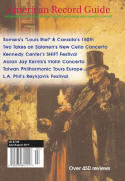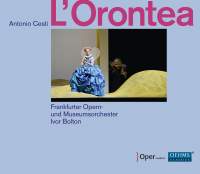Texte paru dans: / Appeared in: |
|
|
Outil de traduction ~ (Très approximatif) |
|
|
Reviewer: John
W. Barker Antonio Cesti (1623-69) belonged to the highwater generation of opera composers in the Venetian tradition and style. His operas were widely admired in their day, but Cesti’s reputation has slipped under the shadow of his elder contemporary, Cavalli, at least at present. Orontea was perhaps his most effective opera. It was composed for the Hapsburg Archduke of the Tyrol and first performed at Innsbruck in 1656. Its libretto is all too typical of Baroque theatrics. To recount its plot would take almost as long as listening the opera itself. Suffice it to say that it is about the amorous tetrangles and pentangles swirling around the court of the imaginary queen of Egypt, Orontea—who herself is about the most fatuous person involved. When the entangle-ments are worked out at the end, Orontea gets the rather opportunistic painter-king, Alidoro; Corindo gets Silandra; and Giacinta gets the boot. Cesti’s score is a model of transitional style.
That is to say, the later
Neapolitan formula strictly distinguishing between recitative and aria had
not yet become established, and the basic texture here is the earlier
monodic style of flowing solo writing. That could easily result in solo
monologs of considerable lyric beauty -Cesti was a fine tunesmith. Ensemble
and choral sections still clung to an essentially madrigalian character. In
addition, the dramatic structure was not a matter of the later choice
between opera seria and opera buffa, but followed Venetian formulas
combining elements of both serious and comic. The best example of the latter
is the clowning character Galone, who is stumbling drunk much of the story
and a real bumbler in general. Other Venetian figures abound: a travesty
tenor as an old woman (Aristea), and a soldier (Tibrino) sung here bya
soprano. Of course, the latter may have been a castrato role, as were
Alidoro and Corindo (countertenors here). For all the distant conventions to
accommodate, there is a lot of lovely listening in this score, and the cast
here is admirable. Murrihy is a full-bodied title character and Adler is a
contrasting ingenue, with strong work by Magiera as the hapless Giacinta.
Bailey has a ball with the comic Galone. Of the countertenors, Sebata is a
very lyrical Alidoro, Rexroth a more rough-hewn Corindo; the bass Geyer is
an appropriately authoritative Creonte.
| |
|
Support us financially by purchasing this disc from eiher one of these
suppliers. Un achat via l'un ou l'autre des fournisseurs proposés contribue à défrayer les coûts d'exploitation |
|
|
|
|
|
Cliquez l'un ou l'autre
bouton pour découvrir bien d'autres critiques de CD |
|




